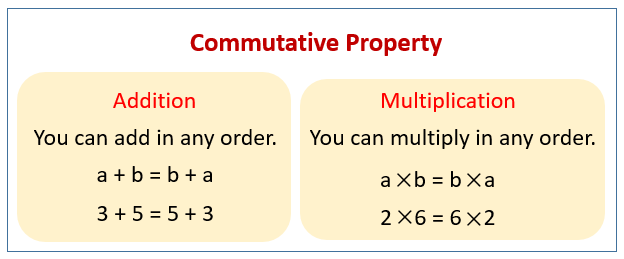Commutative Property
Related Pages
Identity Property Of Addition, Multiplication
More Lessons for Arithmetic
Math Worksheets
In these lessons, we learn what the commutative property means and how to use it in arithmetic operations.
The basic Number Properties (or laws) that apply to arithmetic operations are Commutative Property, Associative Property, Identity Property and Distributive Property.
The commutative property states that the order of numbers in addition or multiplication does not change the result.
The following diagrams show the Commutative Property of Addition and Multiplication. Scroll down the page for more examples and solutions.

Worksheets
Practice your skills with the following worksheets:
Printable & Online Numbers Worksheets
Printable & Online Algebra Worksheets
Commutative Property
An operation is commutative if a change in the order of the numbers does not change the results. This means the numbers can be swapped.
Numbers can be added in any order.
For example:
4 + 5 = 5 + 4
x + y = y + x
Numbers can be multiplied in any order.
For example:
5 × 3 = 3 × 5
a × b = b × a
Numbers that are subtracted are NOT commutative.
For example:
4 – 5 ≠ 5 – 4
x – y ≠ y –x
Numbers that are divided are NOT commutative.
For example:
4 ÷ 5 ≠ 5 ÷ 4
x ÷ y ≠ y ÷ x
The following videos explain more about the commutative property of addition and multiplication.
Summary of Number Properties
The following table summarizes which number properties are applicable to the different operations:
| Number Properties | × | ÷ | + | – |
| Commutative | Yes | No | Yes | No |
| Associative | Yes | No | Yes | No |
| Distributive | Yes | No | No | No |
Importance of the Commutative Property:
The commutative property is fundamental in:
- Simplifying calculations: It allows you to rearrange numbers to make mental math easier (e.g., 17+8+3 can be 17+3+8=20+8=28).
- Algebra: It allows you to reorder terms in expressions (e.g., 3+x is the same as x+3; 5y is the same as y5).
Try out our new and fun Fraction Concoction Game.
Add and subtract fractions to make exciting fraction concoctions following a recipe. There are four levels of difficulty: Easy, medium, hard and insane. Practice the basics of fraction addition and subtraction or challenge yourself with the insane level.

We welcome your feedback, comments and questions about this site or page. Please submit your feedback or enquiries via our Feedback page.